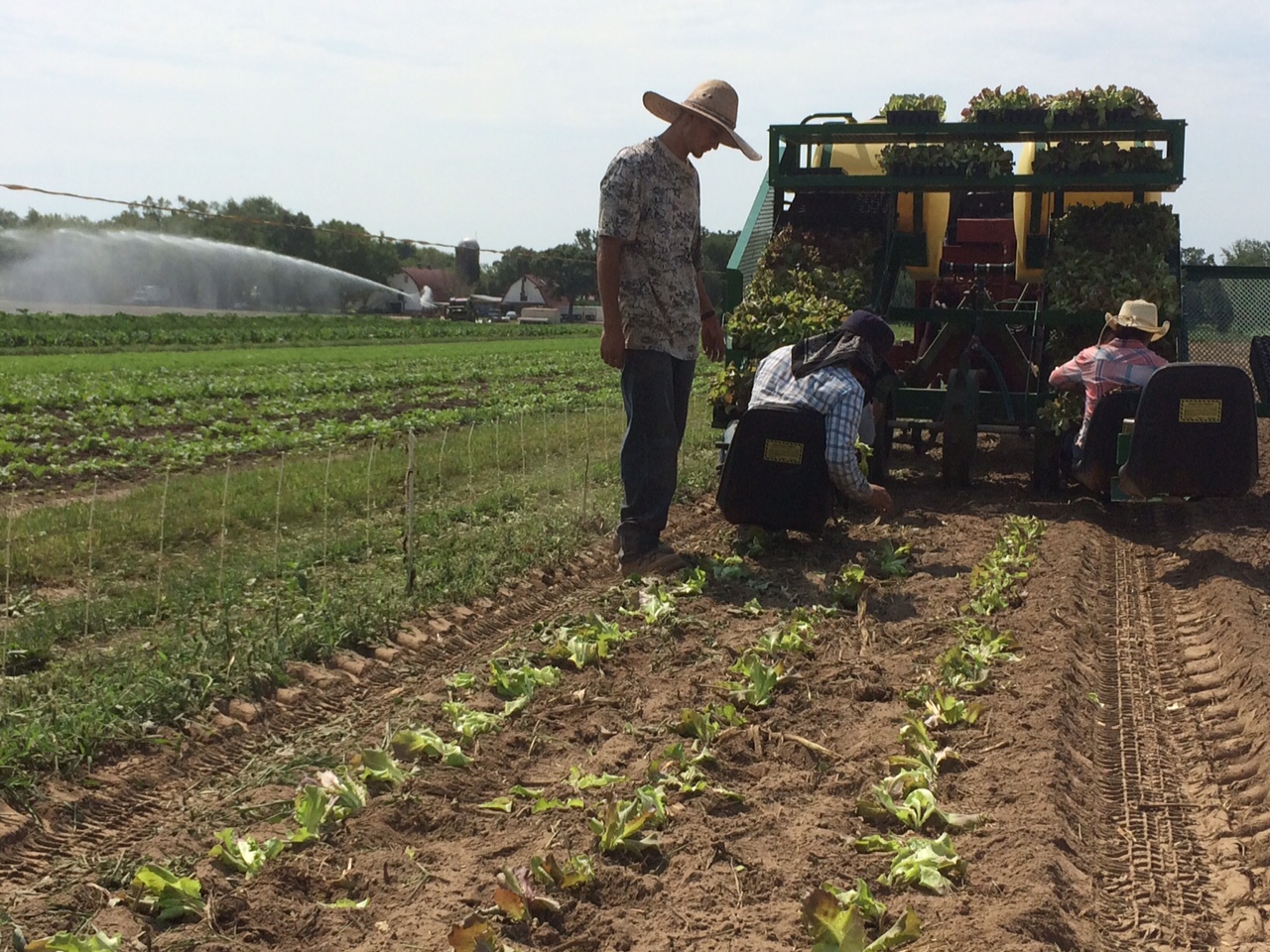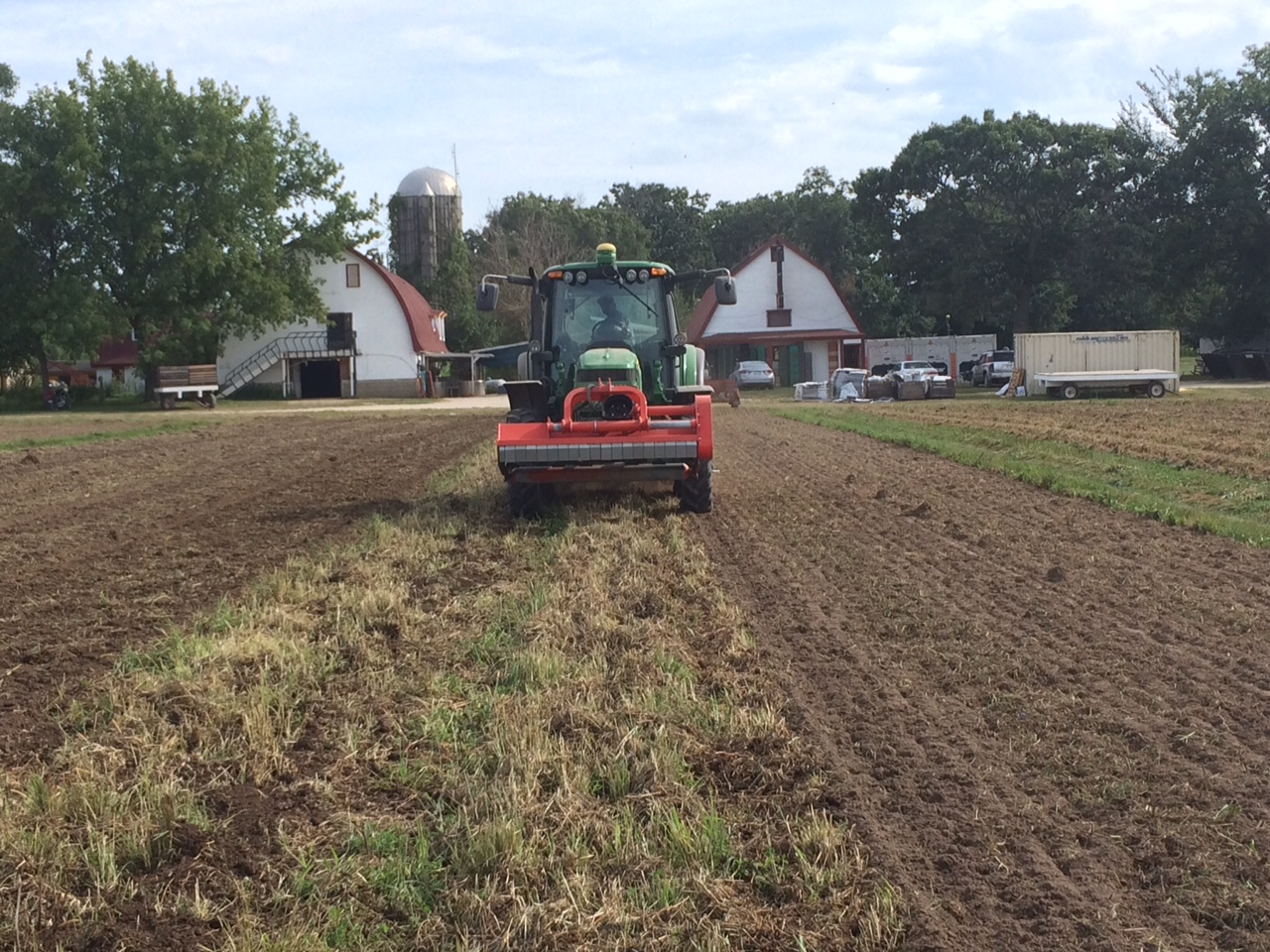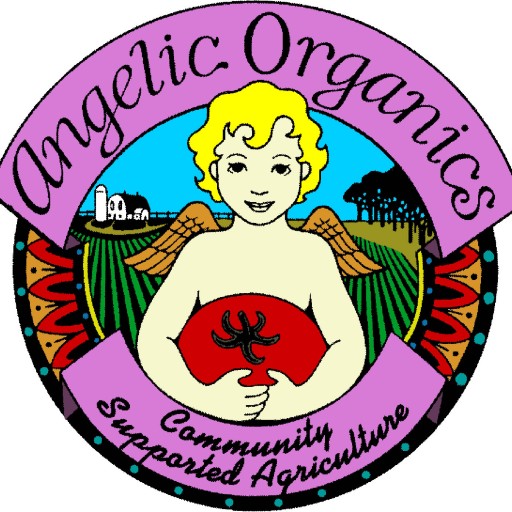Farmer John Writes: about Intention and Happenstance
Welcome to our Eleventh Harvest Week
What’s in Your Box and Why?
In the winter, I script what will go into your box each week of the upcoming growing season. I consult a chart that documents when our crops have been given out week-by-week over the past 10 years. I consult our yield data. I create a matrix in a spreadsheet, predicting when crops will be ready and how much volume of each crop is likely to be available over how many weeks. In real time, these projections then dance with the weather, the reliability of the equipment, the fertility, the quality of the seed, crop diseases, insect pressure, etc. Theory, based on past experience, meets reality, based on the season’s facts.
Too much Mizuna
A shareholder recently wrote the farm, concerned about so much mizuna in her box this season and so little arugula.
The short answer is that the large amount of mizuna was in her box because it was available; the arugula was not.
Here is the long answer.
Planning, then Reality
I include a 10 to 15% buffer in yields, just to make sure that we can fill all the boxes each week. In other words, 10 to 15% of what we grow is grown to make sure that, in case some of my yield projections are wrong, you will still have a full box. This season, quite a few early crops came in below the projections, so it’s fortunate that I create that buffer, because it meant we could fill your boxes even though some of the projections were off. I’ll add that every year, there are crops that come in under projections (and some that come in over the projections). It’s the nature of farming.
This year, I’ve been especially surprised by the lateness of certain crops, notably the normally voluminous spring lettuce and broccoli. Even though they were planted about two weeks earlier than in 2013 and 2014, they matured later than in those years (and strangely, the lettuce heads didn’t size up the way they have in the past two years). I try to determine what might be the cause of this lateness and yield loss, but I often just chalk it up to “anomaly.” We’re not a research farm; we don’t have the resources to document every variable to decide what might have caused lateness, or a modest yield, or earliness or a huge yield. We just move forward, learn some things as we go, unlearn some things, and rely a lot on the averages.
Our sweet corn came on a few days later than usual, too—maybe it was the early coolness of the season, though 2013 and 2014 were also cool, and the corn those years came on at the regular time, even a bit early.
Planning for 2015
This past winter, I re-formatted our normal cropping plan for 2015, in order to have more volume early in the season—we grew more zucchini, for instance, and more early carrots. I toned down the volume for the middle of the season (less lettuce and less baby greens) as the mid-season crops tend to overwhelm the box, and I planted about the same amount as before of late season crops—storage crops, such as potatoes, winter squash and fall brassicas (broccoli, cauliflower, Brussels sprouts, and cabbage). Because our winter squash has been slightly disappointing the last 3 years and our fall brassicas have been stellar, I reduced the winter squash acreage a bit and increased the fall brassica acreage a bit. This year, fall brassicas look stellar and winter squash looks super fantastic—not a trace of the past years’ problems can be seen this year in our winter squash. I must add here that potato yields are almost a joke to predict; the same amount of potato acreage from one year to the next can vary from 50,000 pounds to over 100,000 pounds. This year, it seems the potato crop will easily exceed 100,000 lbs. We’ll know when the harvest is over.
The Arc of the Season
The volume arc of the season goes something like this:
1st 4 weeks—bounty due primarily to greens, spring broccoli and cabbage
week 5 & 6—make sure carrots, fennel, celery, zucchini and cucumbers are available to top off the box (Sometimes watermelons are available in Week 6—not this year).
Week 7 – 11—sweet corn, melons, tomatoes, eggplant, peppers make up the major portion of the box
Week 12—depends on whether fall brassicas, winter squash, and potatoes are ready. If they are not, better have two heads of lettuce available per box, and a lush crop of baby greens, and a large bunch of cooking greens.
Week 13 onward—potatoes, fall brassicas, winter squash, and carrots reliably anchor your box. Of course, we add in some lettuce, baby greens, cooking greens, onions, radishes, turnips, celeriac, and kohlrabi to top off your share.
Notice above that there are two periods in the season when volume can be light, so we have a contingency plan in place—the two weeks or so before sweet corn harvest, and the week or so after sweet corn harvest.
2015 reality check: Even though our corn is almost always ready in the early part of Week 7, it wasn’t ready this year. I had a backup plan—baby greens. Our spring baby greens typically re-grow, so, regarding your greens that had been harvested in the early part of the season, rather than tearing them up after harvest, I let them re-grow, in case we didn’t have sweet corn ready in Week 7. I figure our shareholders would usually prefer something in their box over a hole in their box. The greens that I predicted I would have to choose from in Week 7, in case the sweet corn was not yet available, were arugula, pea shoots, and mizuna.

Victor monitors the transplanting of fall lettuce as we irrigate baby greens in the background. An account of everything that happened on the farm on this particular day would fill more than a newsletter column. Remember our tag line: Your Very Own Farm, Without all the Work!
Harvesting Baby Greens
This year, we have been harvesting our baby greens with a mechanical greens harvester. In the past, we used the labor intensive method—kneeling and cutting handful after handful, then tossing the greens into crates. I mentioned in an earlier newsletter that I acquired this greens harvester not just to save tedious labor, but also to enhance the quality of our greens, since often, the ideal moisture window for harvesting the greens is an hour or less between when the greens are too wet from dew and when they are too dry because the dew lifted fast. And sometimes rain is on its way, and we have to harvest the greens before they get soggy.
This is Farming
Like most new machines, this greens harvester required some acclimating. We set it to cut our arugula too low, and therefore, the arugula did not re-grow. We realized that we had cut it too low by the time we were harvesting our mizuna, and we cut the mizuna at the right height to encourage re-growth. The mizuna re-grew splendidly. The arugula did not re-grow at all, and the pea shoots—well, that’s a somewhat different story—I put the peas in at a different time than I had planned. I had planned to seed them in Week 1 for a Week 5 crop, with the possibility of a Week 7 harvest of re-growth. However, because I missed the first spinach seeding in Week -4 (the fourth week before the first delivery), I ended up seeding peas much earlier than I had planned, so they could be in the box where that spinach I didn’t seed was supposed to have gone. I still felt that after the first pea harvest, I could count on re-growth in Week 7, but the re-growth came on earlier and the peas did not offer a 3rd harvest, even though they will sometimes do that, if the weather is right.
So, that’s why we gave so much mizuna earlier this season. I know it might be hard to follow, but since you are a CSA member, I think it’s important to connect you to the farm in myriad ways, not just through the food, but also through the reasons why certain food never shows up, or shows up late, or early.
Cooking Greens
You’ve noticed that bunches of either kale and chard are (usually) a staple in your box. These two crops respond well to being harvested. When we don’t harvest them, the leaves become a bit ragged and the production slows down. I plan to give one or the other most weeks, but not every single week. This week, I plan to give baby chard greens (these greens are really more towards adolescent than baby, but still luscious and scrumptious) to our shareholders who receive a Wednesday and Saturday delivery, and probably bunched kale to all of our shareholders. (Thursday and Friday shareholders recently received baby chard greens.) Remember, it’s a dance between intention and happenstance.
Every Day is a Sprint
Please know that, in spite of how complex the planting sequences and the considerations might be, I don’t get paralyzed by the need to make decisions. I typically decide on things quickly, and move on. There’s not much time for deliberation in a mixed vegetable operation. It all moves fast, and either I move fast with it, or it gets away from me.
In 2013 and 2014, due to the constant rains we had throughout the season, the melons, squash, and potatoes ripened earlier than normal, due to moisture-induced foliar diseases. This year, in spite of steady rains from the get-go, the foliar diseases are minimal in most of our crops, and our fall crops look fabulous. Also, our melon crop was extremely bountiful. However, our cucumbers didn’t hold up for long—they ripened later and ended earlier than usual. Normally, if the cucumbers get a foliar disease, the melons will also be susceptible—not this year. This year our melon vines held up the best I’ve ever seen. While on the topic of foliar diseases, basil throughout the Midwest and the east has been succumbing to a foliar disease early in the season for a few years now. We only managed to get two basil harvests off of our fields in 2012, 2013 and 2014. This year, we have already harvested gorgeous basil three times, even though, as I have mentioned, we have been inundated all season with rain and mud—the main culprits in foliar degeneration.
It’s not all a Mystery
I’m creating all these pictures for you so you can have more insight into the complexity of CSA crop production and crop projections. I’ve been doing this for 25 years and some things just remain mysteries. One thing is not a mystery—my commitment for your box to always be full of a diversity of fabulous produce. We endure, anticipate and accommodate the whipsaws of nature and crop yields and maturities, always mindful of our goal of providing you with a great box every delivery.
Volume Complaints
Since we fill our boxes to the brim, it’s hard to figure out what to do when a shareholder writes to say they got too little of something and wanted more of it. It’s very seldom that this person suggests what to take out of the box so that there is room for the item they want more of. Most of the time, we can’t just cram more of something into our full boxes; we would have to take something out to get something more in.
By far, the biggest volume complaint is that a shareholder can’t keep up with everything that comes in the box—that it’s simply too much. That’s why we offer the every-other-week share.
Past Crops
We harvested our garlic a little late. We actually harvested it at the same time as usual, but we should have harvested it a little earlier. I thought the rain and mud would make the garlic mature later than usual, but I was wrong. Therefore, the wrappers on some of the garlic bulbs have partially disintegrated. It’s still wonderful garlic, just not as classic in appearance. The variety, by the way, is German White Porcelain.
Cucumbers–done; zucchini–done; sweet corn–not quite done; we’ll harvest the last of it this week.
Future Crops
The fall greens are all seeded and growing. One more transplanting of lettuce is scheduled—about 20,000 seedlings. A big final day of transplanting in late August should get all of these lettuce transplants into the ground. Weeding is mostly done. Trellising is done. Now we are turning some of our attention to preparing ground for the upcoming year.
Planning for 2016

Primo works up a cover crop of alfalfa and clover to prepare growing beds for 2016. Thirty-three fields will be tilled this August, then receive compost, and then be seeded to peas by September 1st for added fertility.
The Weather
Very hot some days; mostly dry. We irrigate regularly.
Overheard
“Dad, Mom wants her respirator and her smokes.”
Sign up for the Free Recipe
Make sure you sign up for the Local Thyme recipe service we offer with this year’s share. It received many great reviews from our shareholders last season. Go to www.localthyme.net/register. Enter the farm code AOLTFREE under “I am a member of a CSA farm.” Click the sign-up button.
Let us Know
Let Shelly know anything you’d like to share about this week’s box email hidden; JavaScript is required. Please note the week and day of delivery, your site, when you picked up your box, and any comments about your box.
Please Fold Your Boxes Properly and Return
The farm re-uses the vegetable boxes. Flaps are easily torn when the boxes are dismantled improperly, and then the box bottom might later burst open with fresh, organic local produce heading towards the floor. Please return your empty, flattened vegetable box to your delivery site. If you receive home delivery, place it in the location where your box is delivered.
More from Shareholders
Visit us often at www.facebook.com/angelicorganics , where we post exciting farm developments regularly, and shareholders post recipes, tips, and photos.
Saturday’s Box Contents
Please Note: this summary is written before you receive your box—be aware that some guesswork is involved. As always, be sure to thoroughly wash all of your vegetables.
Salad Greens –baby chard
Fruiting Crops – sweet peppers, sweet corn, hot peppers, tomatoes, melons
Cooking Greens – kale
Alliums – onions
Your Farmer, John
Coming up at Angelic Organics Learning Center: Food Preserving 101
Saturday, August 29, 1pm-4pm.
If you’ve ever felt overwhelmed by the abundance in your CSA box or wished that you could eat local even in December, this is the class for you. You’ll get hands-on experience canning tomatoes, and we’ll also discuss freezing and dehydrating, with a focus on how to fit food preservation into your family’s busy life. More info and registration on our website: www.learngrowconnect.org/events



